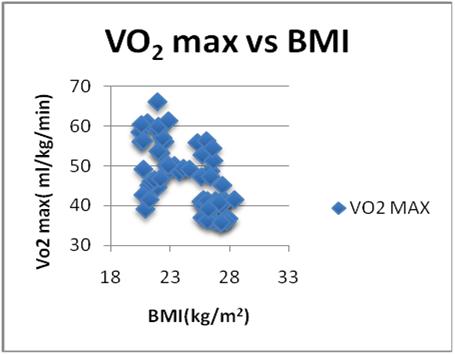
A Study on Physical Fitness Index and Predicted Maximum Aerobic Capacity (VO2 Max) Among Young Male Individuals
Abstract
Introduction: There is increased prevalence of
obesity among adolescents due to sedentary life style, faulty
food habits and lack of physical activity. Overweight and
obesity are associated with hemodynamic changes at rest.
Whether these changes are reflected in exercise needs to
be ascertained. Physical Fitness Index (PFI) is one of the
important criteria to assess the cardiopulmonary efficiency of
a subject. This study was aimed to find out whether or not
obesity affects cardiovascular functional abilities in young
male individuals. Aim: The aim of the study is to assess and
compare the cardiovascular response to exercise in young
normal weight and over-weight subjects by comparing
Physical Fitness Index (PFI) score obtained by Astrand
Ryhming Step Test and predicted VO2 max value obtained
using Astrand Ryhming Nomogram method. Method: 60
male medical students in the age group of 18-20 years were
selected consisting of 30 over-weight subjects and 30
normal weight subjects as determined by their Body Mass
Index (BMI). For Astrand Ryhming Step Test, the subjects
were asked to step up and down on an 40 cm (16 inch) high
platform at a rate of 22 cycles per minute for 5 minutes.
Physical Fitness Index score calculated. Predicted VO2 max
calculated from Astrand Ryhming Nomogram. Observations
and Results: PFI score and predicted VO2 max value
between two groups were analyzed using student t test and
found to be statistically significant (p value <0.05). There is
significant negative correlation between BMI and PFI score
(r value = -0.417, p value <0.05), BMI and predicted VO2
max. (r value = -0.607, p value <0.05). Conclusion: This
study shows that young overweight individuals have a
poorer cardiovascular response to exercise as compared to
normal individuals. The results of this study emphasizes the
need for early identification of the risk factors leading to
excessive weight gain and initiation of preventive measures
in order to prevent the deterioration of cardiovascular
performance in susceptible young adults.
Full Text:
PDFReferences
Akre, Ambarish & Bhimani, Neha. Co- Relation between
Physical Fitness Index (PFI) and Body Mass Index in
Asymptomatic College Girls, Journal of Exercise Science and
Physiotherapy, Vol. 11, No. 2, June 2015: 129-133.
Angesh H. Bagade1, Megha S. Bhonde, Lalit Nikam,
Cardiac response to exercise determined by physical fitness
index in young obese and normal-weight medical students
Indian Journal of Basic and Applied Medical Research; March
: Vol.-4, Issue- 2, P. 389-393
Astrand I. Aerobic work capacity in men and women with
special reference to age. Acta Physiol Scand Suppl. 1960;
(169):1-92.
Astrand PO, Ryhming I. A nomogram for calculation of
aerobic capacity (Physical fitness) from pulse rate during
submaximal work. J Appl Physiol 1954; 7: 218-221.
Bandyopadhya A. Cardiorespiratory fitness in obese girls.
Indian J Physiol Pharmacol, 2012; 56(4): 393-395.
Brouha I, Health CW, Gray B. A step test simple method of
measuring physical fitness for hard muscular work in adult
men. Rev Canadian Biol 1943;2:86.
Chechukwu Dimkpa. Post-Exercise Heart Rate Recovery:
An Index Of Cardiovascular Fitness. Journal of Exercise
Physiology online 2009; 12(1):19-22.
Hill JO & Trowbridge FL. Symposium on the causes and
health consequences of obesity in children and adolescents.
Pediatrics 1998; 101: S497-S574.
Laxmi CC, Udaya IB, Vinutha Shankar S Effect of body
mass index on cardiorespiratory fitness in young healthy
males International Journal of Scientific and Research
Publications, Volume 4, Issue 2, February 2014
Patkar KU, Joshi AS. Comparison of VO2max in obese
and non-obese young Indian population. Indian J Physiol
Pharmacol. 2011;55(2):188-192.
Ryhming I. A modified Harvard Step Test for Evaluation
of Physical Fitness. Arbeitsphysiologie 1953;15(3):235-50.
Serkan Cay. Heart Rate Recovery after exercise; An
important criterion, International Journal of Cardiology 2009;
(137): 187-188.
Setty P, Padmanabha B, Doddamani B. Correlation
between obesity and cardio respiratory fitness. Int J Med Sci
Public Health 2013; 2(2): 300-304.
Shrivastav S, Dhar U, Varun Malhotra. Correlation
between physical fitness and body mass index IJCRR 2013;5
(23):44-48.
World Health Organization. Global Database on Body
Mass Index. BMI Classification. World Health Organization
website, 2000.
Refbacks
- There are currently no refbacks.

This work is licensed under a Creative Commons Attribution-NoDerivatives 4.0 International License.
An initiative of The Tamil Nadu Dr M.G.R. Medical University